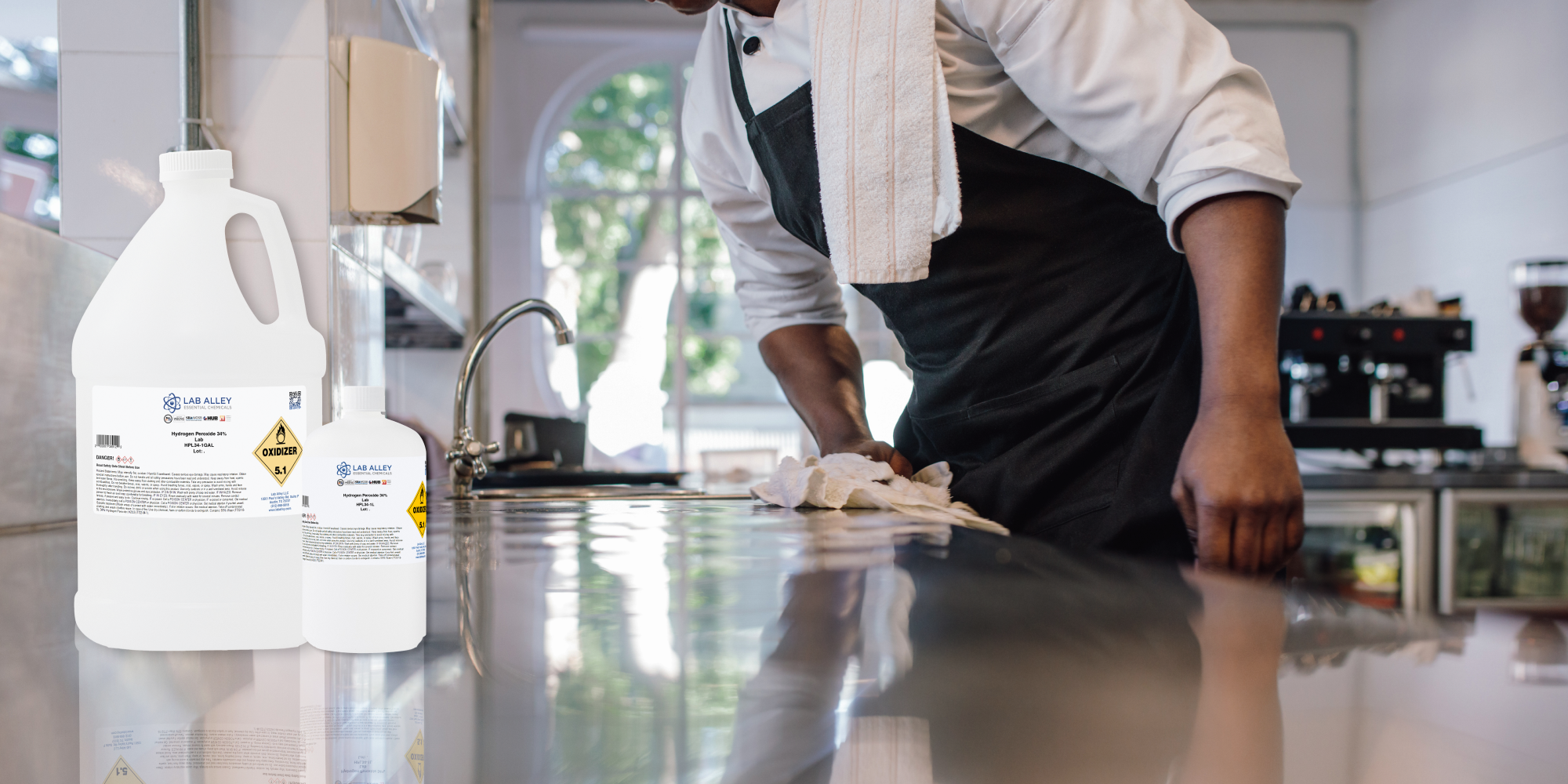Make an Effective Cleaner with Hydrogen Peroxide

What is it exactly about hydrogen peroxide that makes it so advantageous? In this article, we’ll explain what hydrogen peroxide is, how it works as a cleaning agent, and how to make an effective cleaner with hydrogen peroxide.
Hydrogen peroxide can be used to make an effective, broad-spectrum cleaning agent that is also safe for humans and the environment. This little molecule has several disinfectant properties without the toxicity we often associate with other highly effective cleaning chemicals (for example, chlorinated solvents).
What is hydrogen peroxide?
Hydrogen peroxide is a clear liquid, familiar from most home medicine cabinets as well as most chemistry labs. It is best known as a powerful oxidizer.
The molecular formula is H2O2, notably similar to that of water, H2O, yet critically different. However, the similarity to water does come into play crucially, as hydrogen peroxide readily breaks down to form water and oxygen. Here is the chemical formula for the breakdown of hydrogen peroxide:
2H2O2 → 2H2O (l) + O2 (g)
Importantly, this break-down reaction is part of what makes hydrogen peroxide so advantageous compared to alternative disinfectant chemicals. Notice how the product compounds are completely innocuous – just water and oxygen. In fact, not only are they non-toxic, they are actually critical to life.
In a less obvious way, hydrogen peroxide is also critical to life. It is actually produced within our very own cells, where it is important for wound healing, innate immunity, and apoptosis (non-pathological cell death). Within your cells, an enzyme called catalase breaks down hydrogen peroxide to form water and oxygen, according to the above reaction. This allows hydrogen peroxide to perform its critical role without causing harmful oxidation to the cell.
Despite its ability to degrade into water and oxygen, hydrogen peroxide is actually a relatively stable compound. If stored properly away from heat and light, it will undergo degradation at a rate of less than 2% per year.
What makes hydrogen peroxide a good cleaning agent?
In addition to its valuable stable and relatively non-toxic properties, hydrogen peroxide is desirable for its broad-spectrum biocidal activities. It can kill multiple different microorganisms, including:
- Bacteria
- Viruses
- Fungi
- Yeasts
- Spores
This broad-spectrum biocidal activity is attributable to the powerful oxidizing capabilities of hydrogen peroxide. It produces highly reactive hydroxyl radicals, which readily attack critical cell components of microorganisms. For example, the hydroxyl radicals set free on microorganisms will destroy lipids, proteins, and/or nucleic acids (DNA) via oxidation.
This is similar to what is happening in nature, with the endogenous hydrogen peroxide produced in your cells. This is often cited as proof of the safety of hydrogen peroxide. However, it is still important to acknowledge and understand the difference between endogenous hydrogen peroxide and hydrogen peroxide introduced from outside the cell.
For example, using hydrogen peroxide to sanitize a wound is actually no longer advised. That’s because hydrogen peroxide destroys not only the bacterial cells in the area, but also your own immune cells which have been sent to the area to combat infection and heal the wound.
Using hydrogen peroxide to disinfect inanimate surfaces, on the other hand, is a perfectly valid use. Hydrogen peroxide cleaners can be used for the following applications:
- Disinfection of medical equipment
- Disinfection of food surfaces
- Cleaning edible produce
- Water treatment
- Cleaning hard surfaces
The oxidizing properties of hydrogen peroxide also make it a good bleaching agent. It works best on brightly-colored stains by breaking down the pigmented molecules so that the stain “disappears.”
How to make an effective cleaner with hydrogen peroxide
When formulating a cleaning agent with hydrogen peroxide, you’ll want to take into consideration parameters such as concentration and pH.
Hydrogen peroxide is most effective as a disinfectant within the concentration range of 3% to 25%. Household hydrogen peroxide is usually around 3%, although for industrial and laboratory applications higher concentrations are applicable.
The pH of the formulation presents a slight tradeoff between efficacy and stability. Low pH formulations offer better stability. However, the bleaching properties of hydrogen peroxide are more effective at high pH. Since laundry detergent tends to be alkaline, mixing hydrogen peroxide with detergent is a good way to exploit the bleaching capabilities. Bleaching formulations will take advantage of this same principle, by incorporating an alkalizing agent.
Where to buy hydrogen peroxide
If you’re planning to use hydrogen peroxide as a cleaning agent or to create a new cleaning formulation, you can find the highest quality chemicals at Lab Alley. All of our chemicals are sustainably and ethically sourced, competitively priced, and easy to order.

